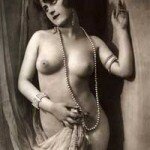Erotic Freedom. We have had 25,000 years of it, according to Alan Moore in his book titled 25,000 Years of Erotic Freedom:
With each new technological advance, pornography has proliferated and degraded in quality. Today, porn is everywhere, but where is it art?
25,000 Years of Erotic Freedom surveys the history of pornography and argues that the success and vibrancy of a society relates to its permissiveness in sexual matters.
This history of erotic art brings together some of the most provocative illustrations ever published, showcasing the evolution of pornography over diverse cultures from prehistoric to modern times. Beginning with the Venus of Willendorf, created between 24,000-22,000 bce, and book-ended by contemporary photography, it also contains a timeline covering major erotic works in several cultures. 25,000 Years of Erotic Freedom ably captures the ancient and insuppressible creative drive of the sexual spirit, making this book a treatise on erotic art.
TIMELINE OF EROTIC FREEDOM
(excerpt from Alan Moore’s 25,000 Years of Erotic Freedom)
- Venus of Willendorf created 24,000-22,000 B.C.
- Founding of Rome (753 B.C.)
- Greek artists create pornographic drawings & paintings on amphora, goblets, and vases (5th century B.C.)
- Romans paint frescoes in Villa Dei Misteri at Pompeii of sexual acts and erotic images (1st century B.C.)
- In Middle Ages, hundreds of erotic carvings found on colonnades of Gothic churches
- sculpture of David by Donatello (1430-32)
- Birth of Venus painting by Botticelli (1480)
- Savonarola, a notorious and powerful censor, persuades artists of Firenze, Italy to destroy their nude art (1497)
- Pope Paul III establishes the Universal Roman Inquisition and condemnation of “immoral works of art” (1542)
- Pope Paul IV creates a list of books he banned to the Inquisition (1559)
- The Council of Trent of the Catholic Church issues the “Librorum Prohibitum” updated until 1948, including more than 4,000 works. The index was rescinded in 1965. (1564)
- Licensing Act of 1662 gives the English courts a mandate to “suppress indecent publications” (1662)
- “PORNOGRAPHY” comes into widespread use as a term in 19th century, appearing in the Oxford Dictionary (1857)
- Scandal of Oscar Wilde’s trials (1895)
 Erotic Freedom has survived since the Victorian period. Since playwright Oscar Wilde was convicted of “gross indecency” in the stifling era of censorship for his writings and sexual preference, we have begun to loosen the bindings of sexual & erotic repression, dancing with the Great Goddess into the next millennium. Artists, writers, poets, novelists, photographers, sculptors, painters, musicians, burlesque dancers, belly dancers, prostitutes, web cam performers, lesbians, gays, straights, bi-sexuals, transgenders, hermaphrodites, erotic models, pornographers, erotic artists, shibari enthusiasts & artists, polyamorists, creative beings of the world, male and female, have the right to be sexually free and express themselves.
Erotic Freedom has survived since the Victorian period. Since playwright Oscar Wilde was convicted of “gross indecency” in the stifling era of censorship for his writings and sexual preference, we have begun to loosen the bindings of sexual & erotic repression, dancing with the Great Goddess into the next millennium. Artists, writers, poets, novelists, photographers, sculptors, painters, musicians, burlesque dancers, belly dancers, prostitutes, web cam performers, lesbians, gays, straights, bi-sexuals, transgenders, hermaphrodites, erotic models, pornographers, erotic artists, shibari enthusiasts & artists, polyamorists, creative beings of the world, male and female, have the right to be sexually free and express themselves.
“The books that the world calls immoral are the books that show the world its own shame.” ~ Oscar Wilde
(1885-1930) D.H. Lawrence, an English writer, was a famous novelist, poet, playwright, essayist, and literary critic. His novel, Lady Chatterley’s Lover, was censored when it was first published in 1928, and it was later part of a trial under the Obscene Publications Act. But D. H. Lawrence was true to his erotic expressions in his literature, not to be cast aside as “smut” :
Lawrence’s opinions earned him many enemies and he endured official persecution, censorship, and misrepresentation of his creative work throughout the second half of his life, much of which he spent in a voluntary exile he called his “savage pilgrimage.”At the time of his death, his public reputation was that of a pornographer who had wasted his considerable talents. E. M. Forster, in an obituary notice, challenged this widely held view, describing him as, “The greatest imaginative novelist of our generation.” {quote from Wikipedia}
He was not alone.
Henry Miller, James Joyce, and Walt Whitman, to name a few. Here is a list of Banned Books in history. Oscar Wilde’s play “Salome” was deemed “vulgar,” and Tennessee Williams’ play “A Streetcar Named Desire” was “controversial” because of the story of a woman’s rape and mental decline.
Writer Henry Miller, lover of Anaïs Nin, published his first printing of Tropic of Cancer in 1934, and all of his books were banned in the United States, as his works contain detailed accounts of sexual experiences. His writing opened the doors of sex in American writing. He continued to write novels that were banned in the United States on the “grounds of obscenity.”
James Joyce’s Ulysses was banned for “obscenity.” In 1998, the Modern Library ranked Ulysses first on its list of the 100 best English-language novels of the 20th century.
Ulysses was an epic groundbreaking novel that was cause for much controversy due to its “Obscenity Allegations” :
“Written over a seven-year period from 1914 to 1921, the novel was serialized in the American journal The Little Review from 1918 until the publication of the Nausicaä episode led to a prosecution for obscenity. In 1919, sections of the novel also appeared in the London literary journal The Egoist, but the novel itself was banned in the United Kingdom until the 1930s. In 1920 after the US magazine The Little Review serialised a passage of the book dealing with the main character masturbating, a group called the New York Society for the Suppression of Vice, who objected to the book’s content, took action to attempt to keep the book out of the United States. At a trial in 1921 the magazine was declared obscene and, as a result, Ulysses was banned in the United States. In 1933, the publisher Random House arranged to import the French edition and have a copy seized by customs when the ship was unloaded, which it then contested. In United States v. One Book Called Ulysses, U.S. District Judge John M. Woolsey ruled on December 6th 1933 that the book was not pornographic and therefore could not be obscene, a decision that was called “epoch-making” by Stuart Gilbert.The Second Circuit Court of Appeals affirmed the ruling in 1934.Contrary to popular belief, Ulysses was never banned in Ireland.” {quote from Wikipedia under “Ulysses”}
All artists, writers, and creative people have the right to express themselves in art. Erotica, literature, paintings, poetry, music, and dance forms have the artistic freedom to involve the erotic. What about French Erotic postcards? Love letters? Erotic photography?
But we have much to celebrate. The latest and greatest news of New York Legislature passing a “same sex marriage” bill has us all shouting Let Freedom Ring!
“All censorships exist to prevent any one from challenging current conceptions and existing institutions.” ~ George Bernard Shaw
Fig leafs once covered genitals on sculptures. Paintings that were deemed “immoral” were covered and banned from museums. Writers were censored, and even criticized for their sexual identities. Like Oscar Wilde’s homosexual preferences, Walt Whitman was insulted for his presumed “bisexuality” based on his writings:
“Whitman’s sexuality is generally assumed to be homosexual or bisexual based on his poetry, though that has been at times disputed. His poetry depicts love and sexuality in a more earthy, individualistic way common in American culture before the medicalization of sexuality in the late 19th century. Though Leaves of Grass was often labeled pornographic or obscene, only one critic remarked on its author’s presumed sexual activity: in a November 1855 review, Rufus Wilmot Griswold suggested Whitman was guilty of “that horrible sin not to be mentioned among Christians”. Whitman had intense friendships with many men and boys throughout his life. Some biographers have claimed that he may not have actually engaged in sexual relationships with males, while others cite letters, journal entries and other sources which they claim as proof of the sexual nature of some of his relationships.” (quote from Wikipedia)
Memoirs of a Woman of Pleasure (known as Fanny Hill) by John Cleland was the first published erotic novel in England in 1748. Fanny Hill is considered the first original English prose pornography in novel form. It is one of the most prosecuted and banned books in history.
Quotes from Fanny Hill:
“I felt her dear lips again pressing and sucking my engine of love.”
“…and now, disengag’d from the shirt, I saw, with wonder and surprise, what? not the play-thing of a boy, not the weapon of a man, but a maypole of so enormous a standard, that had proportions been observ’d, it must have belong’d to a young giant. Its prodigious size made me shrink again; yet I could not, without pleasure, behold, and even ventur’d to feel, such a length, such a breadth of animated ivory!”
Let’s rejoice! Let us Sing The Body Electric! We have Erotic Freedom! No more fig leafs, no more censorship, freedom for all. And for those who are in difficulty, pain, in oppression and suppression, those in sexual slavery, let us work toward freedom for all human beings to be healthy, happy, and free.
Find organizations to help stop violence towards all people for their erotic, sexual and human rights.
- SOROPTIMIST helps stop sex slavery & trafficking
- support sex workers SWAAY Sex Work Activists, Allies and You
- Sexual Freedom Activist Network
(photos courtesy of www.abbywinters.com)












































